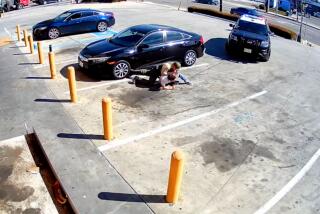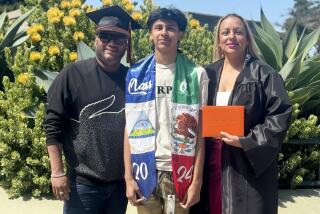Critics of Beating May Be Stymied
- Share via
In the days since a Los Angeles police officer beat a black suspected car thief as cameras rolled, some civic leaders have demanded that the officer be brought to justice. But if by justice, they mean a criminal conviction, they might not be satisfied.
The videotape, as Police Chief William J. Bratton has acknowledged, “looks very bad.” Officer John J. Hatfield is shown kicking at Stanley Miller, who is sprawled face down, and then hitting him 11 times with a flashlight.
But those images, though troubling, are only one part of a potential case and are not enough to ensure a conviction. In a number of highly publicized cases, including some in which the incidents were videotaped, the officers either were never charged or were not found guilty.
In the most well-known example, the 1992 Superior Court trial of four LAPD officers who beat Rodney G. King ended in acquittals on all but one count, sparking deadly rioting across Los Angeles. Two of the officers were convicted later in federal court of violating King’s civil rights.
“You need to persuade all 12 members of this diverse community in L.A. or anywhere else that the person should be held criminally responsible -- and that’s a high burden,” said former federal prosecutor Michael Gennaco. “It’s difficult, but not impossible.”
During protests and news conferences last week, civic and religious leaders condemned Hatfield’s actions and called the case a test of whether the city and the Police Department really have changed since the 1991 King beating.
John D. Barnett, who has defended several officers, said community leaders “create high expectations with low percentage of success” by making early judgments on an officer’s guilt. “It breeds fear and resentment,” Barnett said.
Even when a violent arrest is caught on tape, prosecutors say they face obstacles in police use-of-force cases. Jurors are frequently reluctant to convict officers for their actions while on duty, especially if they offer a reasonable explanation.
Jurors tend to find police officers more sympathetic than their victims, who often have criminal records. And they recognize that officers have the authority to use force, and may disagree on how much is too much, especially when officers have to make those decisions in an instant.
In February, the Los Angeles County district attorney’s office dropped its case against former Inglewood police officer Jeremy Morse, who was videotaped in 2002 slamming a 16-year-old boy on the trunk of a patrol car and punching him in the jaw.
Two juries deadlocked on the charges. One juror said she didn’t believe 12 people would ever agree on whether Morse used excessive force.
After deciding not to retry the case a third time, Dist. Atty. Steve Cooley issued a statement saying, “Prosecutions against police officers are difficult ones because of the positions that they hold as protectors of the community. Our position has been, and remains, that when the handcuffs go on and resistance has stopped, use of force must also cease.”
In the aftermath of Miller’s beating, Bratton launched criminal and internal investigations. Cooley, whose office is helping with the criminal probe, promised he will “move quickly to ensure accurate justice” and will prosecute the officers “if facts support the filing of criminal charges.” Eight officers who took part in the arrest have been assigned to desk duty pending the outcome of the investigations.
They could be charged in state court with using excessive force, lying on a police report or assault with a deadly weapon. In federal court, they could be charged with violating the victim’s civil rights. And they could face civil lawsuits.
The department also could discipline the officers.
The LAPD’s Bureau of Professional Standards is investigating the beating and will forward its report to Bratton, who can recommend a penalty ranging from a reprimand to termination. The officer can accept the discipline or challenge it.
If the officer appeals, a Board of Rights with two high-ranking officers and one civilian decides on the discipline. Bratton can reduce a punishment, but he cannot increase it.
The chief has called Miller’s arrest a “mess,” noting that the first officer to reach Miller should not have tackled him and saying of Hatfield’s kick, “We don’t teach kicks.” He also has said, “The image of the flashlight looks problematic.”
If the Miller case does go to trial, the videotape could help prosecutors. But attorneys say the video also leaves open some key questions. Without audio, it’s unclear what the officers -- or the suspect -- might have been yelling. Because television news crews taped the arrest from helicopters, it’s also difficult to tell when Miller was handcuffed or to see where Hatfield hit Miller with the flashlight.
The video “does not show subtle events that are perceived by the officers but not by the public,” said Michael P. Stone, who represents officers in use-of-force cases and trains police managers and internal affairs investigators. Videotapes can be deceptive, Stone said, especially if they are shot from a great distance.
And Corey Glave, who also has represented officers, said videos don’t reveal officers’ perceptions during the arrest, which are a crucial factor because they dictate their actions. “The perception of the officers involved is different than what the camera is showing you,” he said.
In one high-profile videotaped beating, state and federal prosecutors in Los Angeles decided not to prosecute two Riverside County sheriff’s deputies who had been taped hitting two illegal immigrants with batons. The beating occurred after a harrowing, high-speed chase in 1996 that ended in El Monte.
The U.S. attorney’s office concluded that the evidence was insufficient to prove the officers violated civil rights laws.
If a brutality case does go to trial, dueling experts will present contradictory explanations of the video, while prosecutors and defense attorneys will dissect it frame by frame with an eye toward the timing of the events.
“What can be a reasonable use of force can become an unreasonable use of force just with the passage of a few seconds,” said Stone, a former policeman who represented one of the officers accused in the King case.
Former state attorney general and Los Angeles County district attorney John Van de Kamp said a code of silence permeates some police departments, making it difficult to get forthcoming statements from officers.
Often, police beating cases are presented to a grand jury for criminal indictment to compel testimony, under oath, from officers.
To prove officers used unreasonable force, the district attorney’s office has to convince jurors that the officers continued using force after a suspect was subdued. A federal civil rights conviction requires prosecutors prove that the officer acted willfully and intentionally.
Defense attorneys, for their part, try to show jurors that officers make split-second decisions in the field without benefit of hindsight, defense lawyers say.
“You have to put the jury inside the boots of the police officer -- see what he sees, feel what he feels,” said Barnett, who also defended one of the officers in the King case. “Anybody who is willing to resist armed officers is 10 times more dangerous than the average crook.... If he was a minor crook, he wouldn’t be running.”
Jurors also have to be convinced that the officers believed they were in danger, defense lawyers said. In this case, Miller led police on a car chase and a foot pursuit, and Hatfield has told investigators that an officer yelled that Miller had a gun, sources close to the investigation have told The Times.
In some police shootings, prosecutors have declined to file criminal cases after determining that officers might have acted in self-defense.
The Los Angeles County district attorney’s office decided not to charge an LAPD officer in the 1999 fatal shooting of Margaret Mitchell, a slightly built, mentally ill woman who brandished a screwdriver. Prosecutors said either Officer Edward Larrigan acted in self-defense or the shooting was an accident.
Jeffrey C. Eglash, a former LAPD inspector general, said the mixed outcome of police beating cases should not deter prosecutors.
“These cases are tough, but you need to bring them,” he said. “You allow the jurors to be the conscience of the community.”
*
Times staff writer Richard Winton contributed to this report.
*
(Begin Text of Infobox)
Outcomes of Some Recent Cases
*
Many police shootings or beatings in Southern California have not resulted in criminal charges. Others were prosecuted but ended in acquittals or mistrials.
Here’s a look at a few high-profile cases:
* Four LAPD officers charged in the videotaped beating of Rodney G. King in 1991 were acquitted in Superior Court, sparking massive urban riots. Two of the officers were convicted later in federal court of violating King’s civil rights.
* Two Superior Court juries could not reach a unanimous verdict on murder charges against LAPD Officer Douglas Iversen, who was charged with shooting a tow-truck driver as he drove away from a gas station in 1992. The charges were dropped.
* State and federal authorities did not file charges against two Riverside County sheriff’s deputies, Tracy Watson and Kurt Franklin, who were videotaped beating two Mexican immigrants with batons after a high-speed chase in 1996 that ended in El Monte.
* The federal case against Oxnard police Officer Robert Flinn, accused of beating an unarmed burglary suspect with a metal flashlight in 1996, ended with a deadlocked jury. Flinn was acquitted in Superior Court on some of the charges.
* Four Riverside police officers involved in the 1998 fatal shooting of Tyisha Miller, who had passed out in her car with a gun in her lap, were cleared of criminal wrongdoing by state and federal prosecutors.
* The Los Angeles County district attorney’s office and the U.S. attorney’s office did not file criminal charges against LAPD Officer Edward Larrigan, who killed a homeless, mentally ill woman who threatened officers with a screwdriver in 1999.
* LAPD Officer Tarriel Hopper fatally shot an actor after the man allegedly pointed a replica handgun at him during a Halloween party in 2000. The district attorney’s office concluded that Hopper had acted in self-defense.
* Los Angeles prosecutors charged Inglewood Police Officer Jeremy Morse in the 2002 videotaped beating of a 16-year-old boy during an arrest at a gas station, but juries deadlocked twice on the charges, and a Superior Court judge dismissed the case.
*
Source: Times reporting
More to Read
Sign up for Essential California
The most important California stories and recommendations in your inbox every morning.
You may occasionally receive promotional content from the Los Angeles Times.













